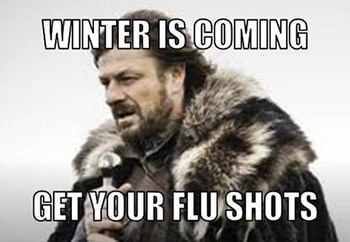Cooler weather brings many anticipated activities, like skiing, snow ball fights and nights in front of crackling fires. However, it also brings the onset of cold and flu season, which puts many people out of commission. While colds and flu viruses are not new, there are still a lot of misunderstandings about what causes them, how to treat them and how to prevent them. That’s why we have compiled this article to help you separate fact from fiction when it comes to keeping your family healthy.
Cold Realities
The common cold is actually caused by up to 200 different viruses, which is partially why people suffer from very different symptoms. The rhinovirus causes the majority of colds and enters your body after you come into contact with another infected person or something that they have touched. As the virus attacks your body, your body fights back. This means that while you feel terrible, your body is actually doing exactly what it is supposed to do. Adults typically suffer from two to three colds a year, while children have between five and seven.

While many people believe that they can catch a cold by getting chilled or going outdoors while wet, this isn’t true. However, there are certain situations that make someone more susceptible to catching a cold. Excessive fatigue, emotional distress and having allergies all puts individuals at a higher risk of catching a cold.
The Truth About the Flu
 The flu, officially called influenza, is another common winter ailment that can lead to serious repercussions and even death. In fact, 200,000 people are hospitalized each year due to the flu and 3,000 to 49,000 people die from it. Most of these individuals are under the age of two or over 65. Often confused with very bad colds, the flu has very distinctive symptoms. While respiratory symptoms can occur, the flu is always accompanied by body aches and a fever. It is never accompanied by nausea, which many people mistakenly call the stomach flu. Many people who contract the flu, reach for antibiotics for relief. However, the flu is a virus not a bacteria, so antibiotics have no effect.
The flu, officially called influenza, is another common winter ailment that can lead to serious repercussions and even death. In fact, 200,000 people are hospitalized each year due to the flu and 3,000 to 49,000 people die from it. Most of these individuals are under the age of two or over 65. Often confused with very bad colds, the flu has very distinctive symptoms. While respiratory symptoms can occur, the flu is always accompanied by body aches and a fever. It is never accompanied by nausea, which many people mistakenly call the stomach flu. Many people who contract the flu, reach for antibiotics for relief. However, the flu is a virus not a bacteria, so antibiotics have no effect.
Flu Vaccines
Flu vaccines are developed each summer in anticipation of the virus most likely to affect people the following fall and winter. They will prevent you from contracting the stain of flu that it was developed for, but doesn’t protect you against other flu strains. That is why in some years there are two flu vaccines. People should get them both to protect themselves against both strains of the flu.
Many myths exist about the flu vaccine, including that it can actually give you the flu. This isn’t true, as vaccines contain no live virus so there is no way it can infect you. However, the vaccine can cause mild symptoms, such as an achy arm or fatigue, which many mistake for the flu. Finally, many people who don’t get the vaccine by late November think that there is no point in getting one. However, physicians emphasize the importance of getting vaccines, as the flu typically doesn’t peak until February.
The takeaway from all of this is to eliminate stress, get plenty of rest and get a flu vaccination every year. And, if you or your family members do get sick, visit a doctor who can make an accurate diagnosis which will help you recover much faster than self- treatment.
The information in this article was obtained from various sources. This content is offered for educational purposes only and does not represent contractual agreements, nor is it intended to replace manuals or instructions provided by the manufacturer or the advice of a qualified professional. The definitions, terms and coverage in a given policy may be different than those suggested here and such policy will be governed by the language contained therein. No warranty or appropriateness for a specific purpose is expressed or implied.
